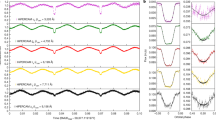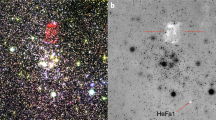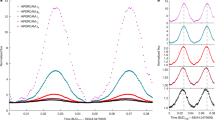Abstract
Classical novae are a subset of the cataclysmic variable (CV) class of objects which undergo outbursts with peak luminosities ˜5×l037–5×l038 erg s–1 every 104–105 years. Around 10–5–10–4M⊙ of material is ejected at velocities typically 1,000 km s–1 at outburst. The central system is a semi-detached binary containing a white dwarf and (usually) a late-type, main-sequence companion. The companion fills its Roche lobe, and loses material, via an accretion disk, onto the surface of the white dwarf. Orbital periods are normally found to be in the range 3–10 h with CV orbits generally of low eccentricity (see ref. 1 for a review). As part of a continuing programme of observations of the old nova GK Persei, we examined Infrared Astronomical Satellite (IRAS) images in the region of the nova, and discovered extended emission in the far infrared. These observations are interpreted in terms of an ancient planetary nebula ejected from the central binary system. If this interpretation is correct, then several unique phenomena associated with GK Per may be explained. In addition, GK Per would then provide valuable clues to the evolutionary status of classical novae, and the later stages of planetary nebula formation.
This is a preview of subscription content, access via your institution
Access options
Subscribe to this journal
Receive 51 print issues and online access
$199.00 per year
only $3.90 per issue
Buy this article
- Purchase on Springer Link
- Instant access to full article PDF
Prices may be subject to local taxes which are calculated during checkout
Similar content being viewed by others
References
Bath, G. T. Q. Jl R. astr. Soc. 19, 442–455 (1978).
Sabbadin, F. & Bianchini, A. Astr. Astrophys. Suppl. Ser. 54, 393–403 (1983).
Schweizer, E. IAU Telegram no. 4274 (1986).
Bianchini, A., Hamzaoglu, E. & Sabbadin, F. Astr. Astrophys. 99, 392–393 (1981).
Crampton, D., Cowley, A. P. & Fisher, W. A. Astrophys. J. 300, 788–793 (1986).
Watson, M. G., King, A. R. & Osborne, J. Mon. Not. R. astr. Soc. 212, 917–930 (1985).
Crampton, D., Cowley, A. P. & Hutchings, J. B. in Cataclysmic Variables and Related Objects (eds Livio, M. & Shaviv, G.) 25–28 (Reidel, Dordrecht, 1983).
Bianchini, A. & Sabbadin, F. Astr. Astrophys. 125, 112–116 (1983).
Perrine, C. D. Astrophys. J. 15, 136–141 (1902).
Couderc, P. Ann. Astrophys. 2, 271–302 (1939).
Swope, H. H. Harv. Obs. Bull. no. 913, 11 (1940).
Van den Bergh, S. Publ. Astr. Soc. Pacif. 89, 637 (1977).
Reynolds, S. & Chevalier, R. Astrophys. J. Lett. 281, L33–L35 (1984).
Bode, M. F., Seaquist, E. R. & Evans, A. Mon. Not. R. astr. Soc. 227, 217–227 (1987).
Beichman, C. A., Neugebauer, G., Habing, H. J., Clegg, P. E. & Chester, T. J. (eds) IRAS Explanatory Suppl. (Jet Propulsion Lab. Publ. JPL, D-1855, 1985).
Low, F. J. et al. Astrophys. J. 278, L19–L22 (1984).
Draine, B. T. Astrophys. J. Suppl. Ser. 57, 587–594 (1985).
Weiland, J. L. et al. Astrophys. J. 306, L101–L104 (1986).
McLaughlin, D. B. in Stars and Stellar Systems Vol. 6 (ed. Greenstein, J. L.) 585–652 (University of Chicago Press, 1960).
Savage, B. D. & Mathis, J. S. A. Rev. Aslr. Astrophys. 17, 73–111 (1979).
Sedov, L. I. in Similarity and Dimensional Methods in Mechanics (Academic, New York, 1959).
Bode, M. F. & Kahn, F. D. Mon. Not. R. astr. Soc. 217, 205–215 (1985).
Kahn, F. D. Astr. Astrophys. 50, 145–148 (1976).
Draine, B. T. & Salpeter, E. E. Astrophys. J. 231, 77–94 (1979).
Draine, B. T. & Lee, H. M. Astrophys. J. 285, 89–108 (1984).
De Vries, C. P. & Le Poole, R. S. Astr. Astrophys. 145, L7–L9 (1985).
Balick, B. in Proc. Workshop on the Late Stages of Stellar Evolution (ed. Kwok, S.) (D. Reidel, Dordrecht, in the press).
Eggleton, P. in Cataclysmic Variables and Related Objects (eds Livio, M. & Shaviv, G.) 239–255 (Reidel, Dordrecht, 1983).
Pottasch, S. R. Astr. Astrophys. 89, 336–341 (1980).
Geiseking, F., Hippelein, H. & Weinberger, R. Astr. Astrophys. 156, 101–105 (1986).
Sabbadin, F., Gratton, R. G., Bianchini, A. & Ortolani, S. Astr. Astrophys. 136, 181–192 (1984).
Iben, I. & Renzini, A. A. Rev. Astr. Astrophys. 21, 271–342 (1983).
Cohen, M. in Planetary Nebulae (ed. Flower, D. R.) 45–55 (Reidel, Dordrecht, 1983).
Author information
Authors and Affiliations
Rights and permissions
About this article
Cite this article
Bode, M., Seaquist, E., Frail, D. et al. An ancient planetary nebula surrounding the old nova GK Persei. Nature 329, 519–521 (1987). https://doi.org/10.1038/329519a0
Received:
Accepted:
Issue Date:
DOI: https://doi.org/10.1038/329519a0
Comments
By submitting a comment you agree to abide by our Terms and Community Guidelines. If you find something abusive or that does not comply with our terms or guidelines please flag it as inappropriate.



